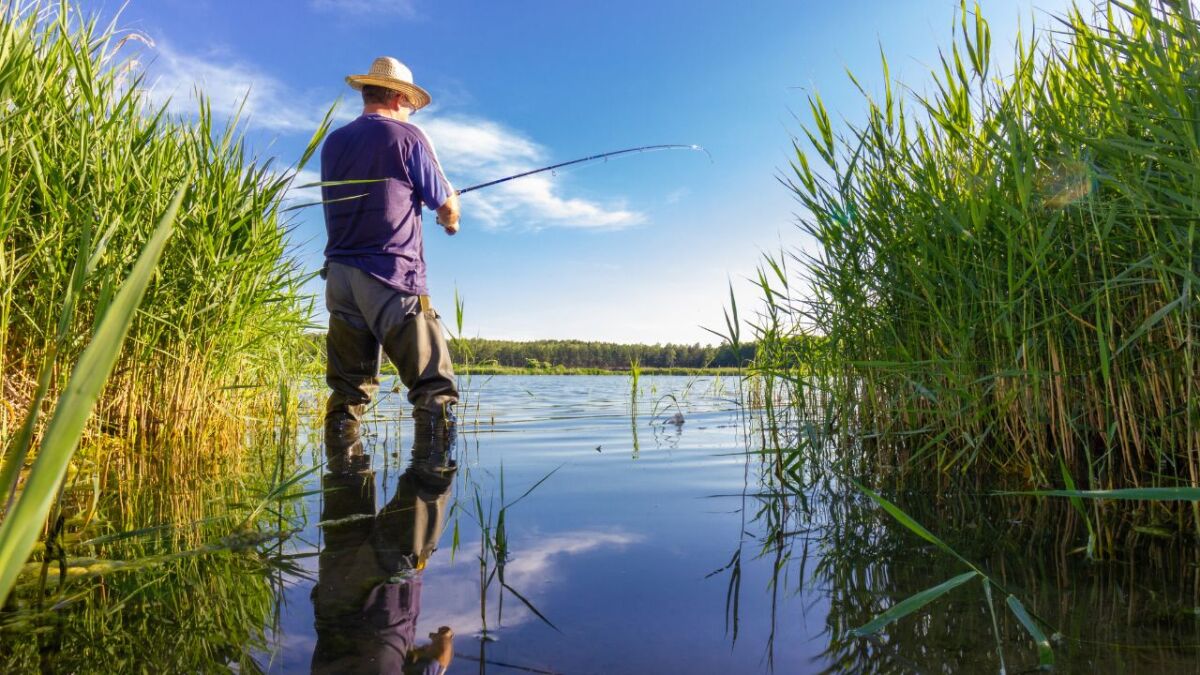
fishing rod
Noun
Meaning
A fishing rod is an essential tool for survival, bushcraft, and outdoor enthusiasts. It is a long, flexible rod used for catching fish in various environments, such as rivers, lakes, and oceans. The fishing rod consists of a thin, lightweight pole made of materials like fiberglass or carbon fiber, with guides and a reel attached to it. It allows you to cast your fishing line into the water and reel in fish when they bite. Fishing rods are versatile and can be used for different fishing techniques, such as casting, trolling, or fly fishing. They are a valuable asset for obtaining food and enjoying the outdoors.

Examples
„I love going fishing in the wilderness. It's so peaceful and relaxing to cast my fishing rod into the clear mountain stream and wait for a bite.“
„Last weekend, I went camping with my friends and we all brought our fishing rods. We spent the whole day by the lake, trying to catch some fish.“
„When I was a kid, my dad taught me how to use a fishing rod. He showed me how to tie the perfect knot and cast the line far into the water.“
„I always make sure to pack my fishing rod whenever I go on a hiking trip. You never know when you'll come across a beautiful fishing spot along the way.“
„My favorite part of fishing is the feeling of excitement when I feel a tug on my fishing rod. It's like a battle between me and the fish, and I can't help but smile when I finally reel it in.“
Origin
The word "fishing rod" originates from the Old English word "rod" which means a slender, straight stick or pole. The concept of using a rod for fishing can be traced back to ancient times, with evidence of fishing rods being used by early civilizations such as the Egyptians and the Chinese.
Over the centuries, fishing rods have evolved and improved in design and materials. In the Middle Ages, fishing rods were typically made from bamboo or other types of wood, with a line attached to the end. As technology advanced, materials such as fiberglass and carbon fiber were introduced, making fishing rods lighter, stronger, and more flexible.
Today, fishing rods come in a variety of types and styles, including spinning rods, casting rods, fly rods, and ice fishing rods. Each type is designed for specific fishing techniques and target species. Modern fishing rods also feature advanced features such as adjustable handles, reel seats, and guides to enhance performance and comfort.
Whether you're a beginner or an experienced angler, having a good fishing rod is essential for a successful fishing trip. It allows you to cast your line further, feel the bites more accurately, and ultimately increase your chances of catching fish.
Synonyms
Fishing pole, Angling rod, Angler's rod, Fishing stick, Fishing cane, Fishing wand, Fishing staff
Antonyms
Reel, Bait, Hook, Line, Sinker, Tackle, Lure, Angling
Relatives
Fishing line, Bait, Hook, Reel, Tackle box, Fishing net, Fishing lure, Fishing tackle
Historical and cultural importance
A fishing rod is a tool used for catching fish. It has a long, flexible rod with a line and a hook attached to it. Fishing rods have been used for thousands of years and have a rich history and cultural significance.
In ancient times, fishing rods were made from natural materials such as bamboo, wood, or bone. They were often handcrafted by skilled artisans and passed down through generations. Fishing was not only a means of survival but also a way of life for many communities, providing food and livelihood.
In different cultures around the world, fishing rods have played important roles. For example, in Japan, fishing rods are an integral part of traditional fishing methods like tenkara, where a long, telescopic rod is used to catch fish in mountain streams. In fly fishing, a specialized type of fishing that originated in Europe, fishing rods are designed to cast a lightweight artificial fly with precision and accuracy.
Over time, fishing rods have evolved with advancements in technology and materials. Modern fishing rods are often made from lightweight and durable materials like carbon fiber or fiberglass, making them more efficient and easier to handle. They come in various lengths, weights, and actions, catering to different fishing styles and target species.
Whether you are a professional angler or a recreational fisherman, understanding the historical and cultural significance of the fishing rod adds depth to your appreciation of this essential tool for the pursuit of fish.
More information about the term fishing rod
The Fishing Rod: A Versatile Tool for the Wilderness
When it comes to survival in the wilderness, having the right tools can make all the difference. One such tool that should never be overlooked is the fishing rod. With its versatility and effectiveness, a fishing rod can provide you with a reliable source of food and a sense of self-sufficiency. Let's dive deeper into the world of fishing rods and explore their importance in the wild.
1. The Basics of a Fishing Rod
A fishing rod is a long, flexible rod made of various materials such as fiberglass, carbon fiber, or bamboo. It consists of several components, including the rod blank, reel seat, guides, and handle. The rod blank is the main body of the rod, while the reel seat holds the fishing reel in place. Guides are small rings that guide the fishing line along the rod, and the handle provides a comfortable grip for the angler.
2. Fishing Techniques with a Rod
With a fishing rod in hand, you can employ various fishing techniques to catch fish in different environments. Some popular techniques include:
- Casting: This involves throwing the bait or lure into the water using the rod's flexibility and the weight of the lure to propel it forward.
- Trolling: This technique involves dragging a baited line behind a moving boat, allowing you to cover a larger area and target fish that are swimming deeper.
- Fly fishing: A specialized technique that uses a lightweight fly rod and an artificial fly to imitate insects on the water's surface, enticing fish to bite.
3. Choosing the Right Fishing Rod
When selecting a fishing rod for survival purposes, there are a few factors to consider:
- Length and weight: Longer rods provide greater casting distance, while shorter rods offer more control in tight spaces. Consider the weight of the rod as well, as you'll want something lightweight and easy to carry.
- Material: Fiberglass rods are durable and affordable, making them a popular choice for survival situations. Carbon fiber rods, on the other hand, are lightweight and sensitive, ideal for more experienced anglers.
- Portability: Look for collapsible or telescopic rods that can be easily packed and carried in a backpack or survival kit.
4. Fishing Rod Maintenance
To ensure your fishing rod remains in good condition, regular maintenance is essential. Here are a few tips:
- Clean your rod after each use to remove dirt, debris, and saltwater residue.
- Check the guides for any signs of damage or wear, as they can affect the performance of your rod.
- Store your rod in a protective case or sleeve to prevent it from getting damaged during transportation.
Conclusion
A fishing rod is a versatile tool that can provide you with a reliable food source in the wilderness. By mastering different fishing techniques and choosing the right rod for your needs, you can increase your chances of success. Remember to practice proper maintenance to ensure your fishing rod remains in top condition for your next adventure. So, grab your fishing rod and head out into the wild – the fish are waiting!
Back to overview

